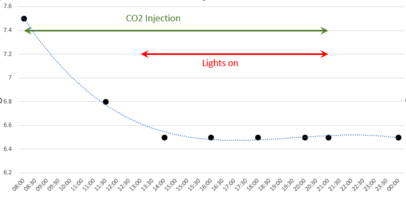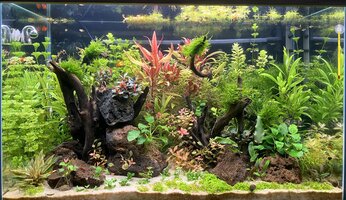Hi - 4 months into my first tank and I wanted to check my CO2 injection performance by compiling a pH profile through the daily cycle. I was pretty convinced that I was lightly dosing the CO2 with only 1.3 bps and drop checker showing green (not light or lime). I read the excellent posting on this forum at Dialling in the CO2 injection Rate and CO2 Profiles My impression is that this profiling is simpler for smaller tanks but the daily cycle could be more difficult - and the needed pre-light injection period substantial for my size of tank.
My tank basics are:
Next day I used a bubble rate of 2.5 per second and a pre-light injection period of 5 hours with the attached resulting profile
It shows a pH drop prior to lights on of about 1 and a steady level during lights on - so early signs good. However, there are some confusing issues:
Picture of tank also provided for info.
My tank basics are:
- 90x60x50 cm so about 230l
- Hardscape: lava rock, driftwood, fluval stratum in bags below riverbed sand.
- Filter is Betta 1040 UV with charcoal, Matrix and Purigen media
- Filter outflow is a spraybar running the length of the tank
- CO2 system is CO2 Art with in-line diffuser
- Basic TNC Complete dosing and JBL Kugeln clay balls using in front substrate.
Next day I used a bubble rate of 2.5 per second and a pre-light injection period of 5 hours with the attached resulting profile
It shows a pH drop prior to lights on of about 1 and a steady level during lights on - so early signs good. However, there are some confusing issues:
- it appears to takes a long time for degassing - at midnight (3 hrs after lights off) CO2 was still at 6.5. By 7:15 the next morning (just prior to CO2 coming back on) it was up to 7.0 but not fully restored to 7.4 as previous day. With a long time to raise pH and slow degassing I was concerned about pH drops becoming cumulative over multiple days
- Really confusing was that my reference sample (removed from tank and let stand for 24 hrs) showed a pH of 8.5. I had to use a regular ph test because this was outside the scale of the narrow range test. Tap water tested at 7.0. I understand that the 1 pH drop should be against the reference sample so i should be aiming for 7.5 during the lighting period.
Picture of tank also provided for info.




